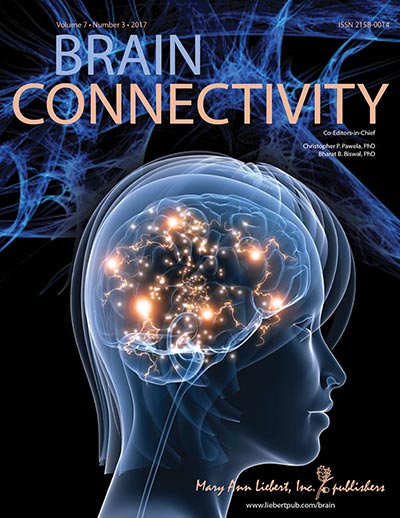For Immediate Release
Do High False Positive Rates Linked to Functional MRI Compromise Results in Neuroimaging Studies?
Contact: Kathryn Ryan
914-740-2250
kryan@liebertpub.com

New Rochelle, NY, May 24, 2017—Challenging recent claims that inflated false positive rates in the analysis of functional magnetic resonance imaging (fMRI) of the brain may negate the findings of countless previous studies, a new review of this controversial topic takes a fresh look at the analytical tools in question. Scientists from the U.S. National Institutes of Health conclude that the effects of a “bug” in the analysis of functional neuroimages (AFNI) software was greatly exaggerated, according to the new study published in in Brain Connectivity, a peer-reviewed journal from Mary Ann Liebert, Inc., publishers. The article is available free on the Brain Connectivity website until June 24, 2017.
In the article entitled “FMRI Clustering in AFNI: False-Positive Rates Redux,” Robert Cox, Gang Chen, Daniel Glen, Richard Reynolds, and Paul Taylor, National Institutes of Mental Health, NIH, Bethesda, MD, repeated some of the earlier simulations performed using the AFNI tools to assess spatial smoothness and clustering of false-positive results on brain neuroimaging. The researchers reported some, though not a particularly high rate of false positives, and described new approaches that show promise in controlling false positive rates.
“Vigorous scientific debate is a key for scientific progression,” states Christopher Pawela, PhD, Co-Editor-in-Chief of Brain Connectivity. “This manuscript from Dr. Bob Cox and colleagues at the NIH is an important part of that ongoing discourse, especially in light of the many recent media reports calling into question the validity of the fMRI methodology.”
Research reported in this publication was supported by the National Institute of Mental Health and National Institute of Neurological Disorders and Stroke under Award Number ZICMH002888. The content is solely the responsibility of the authors and does not necessarily represent the official views of the National Institutes of Health.
About the Journal
Brain Connectivity is the essential peer-reviewed journal covering groundbreaking findings in the rapidly advancing field of connectivity research at the systems and network levels. Published 10 times per year in print and online, the Journal is under the leadership of Founding and Co-Editors-in-Chief Christopher Pawela, PhD, Assistant Professor, Medical College of Wisconsin, and Bharat Biswal, PhD, Chair of Biomedical Engineering, New Jersey Institute of Technology. It includes original peer-reviewed papers, review articles, point-counterpoint discussions on controversies in the field, and a product/technology review section. To ensure that scientific findings are rapidly disseminated, articles are published Instant Online within 72 hours of acceptance, with fully typeset, fast-track publication within 4 weeks. Tables of content and a sample issue may be viewed on the Brain Connectivity website.
About the Publisher
Mary Ann Liebert, Inc., publishers is a privately held, fully integrated media company known for establishing authoritative medical and biomedical peer-reviewed journals, including Journal of Neurotrauma and Therapeutic Hypothermia and Temperature Management. Its biotechnology trade magazine, GEN (Genetic Engineering & Biotechnology News), was the first in its field and is today the industry’s most widely read publication worldwide. A complete list of the firm’s 80 journals, newsmagazines, and books is available on the Mary Ann Liebert, Inc., publishers website.